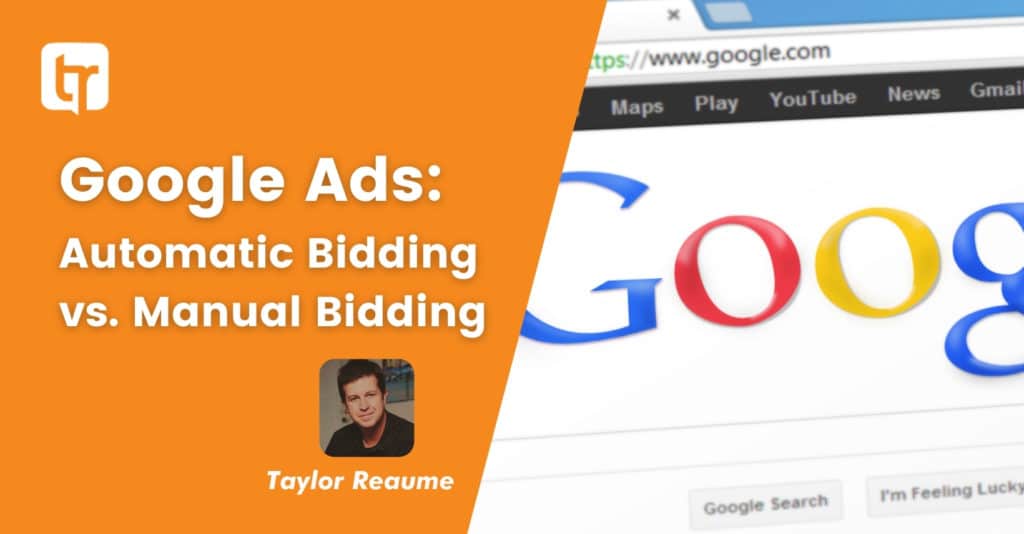Google Ads: Automatic Bidding vs. Manual Bidding

For many companies, Google Ads is an easy and effective way to promote their products and brand.
Google Ads levels the playing field for smaller companies by enabling them to advertise without laying out large sums of capital.
Recently, Google has gone even further by offering the option of allowing artificial intelligence (AI) to run pay-per-click (PPC) campaigns.
This is a risky gambit for many companies. If you have limited resources and a shrinking advertising budget, you may be hesitant to turn over control of your PPC campaign to an automated process.
In this blog, I’ll review several important considerations related to manual bidding versus automated bidding.
Why Companies Use Pay-Per-Click
More and more people are using the Internet to shop, communicate, and socialize. This shift in where the public spends the majority of its time has made Google—the world’s premiere search engine—an advertising giant.
What You Should Know About Manual Bidding
Manual bidding, as the phrase suggests, is the direct and on-hands management of keyword bids on Google Ads. You make all decisions about your PPC account without AI assistance.
Experience, unique market insight and expertise, and analysis of past keyword performance data can all be used to guide such decision-making. However, it should be noted that this process requires a great deal of time and effort. To get a good return on manual bidding, the people involved in it must be highly competent and have the right level of experience.
This form of bidding may be best if you have a limited budget and a small amount of consumer data. The benefits of manual bidding include:
- Control: You can be as aggressive as you want to win bids on specific key words and phrases
- Responsiveness: You can change your keyword bids quickly in response to new competitors and your lowest performers
- No delays: Manual bidding changes take effect immediately
You should also be aware of the downsides of manual bidding. As your PPC account grows bigger, it will become harder to manage. You may be compelled to hire more people to monitor and manage it, which can eat away at your advertising budget. Manual bidding is also vulnerable to human errors, some of which can be quite costly.
What You Should Know About Automatic Bidding
Automatic bidding is also known as smart bidding. This form of bidding is the best option if you have large PPC accounts, a great deal of historical data, and no experts in manual bidding and no desire to hire any.
If you are a growing company or a well-established one with significant capital reserves, you may be better off letting Google AI take charge of your account.
Here are some of the specific benefits of going down this route:
- Versatile segmentation: This involves the creation of customized subsections within your broader target audience based on their shared interests and behaviors
- Efficiency: The AI technology will allow you to manage thousands of keywords and hundreds of ad groups at once
- Accurate prediction models: The advanced algorithms can give you a sound foundation for decision-making by making accurate predictions about your campaigns
- Cost-effectiveness: Your team will spend less time on monitoring your Google Ads accounts, which will free them up for more pressing business matters
While automated bidding is a highly effective way to manage your PPC campaign, in almost all cases, you should not start off with it. The smarter move is to go with manual bidding initially, test the waters, and wait until your account has a steady flow of traffic and you have reached a statistically significant number of conversions from which you can make educated decisions.
You should also be aware that any changes you make to Google Ads will take some time to implement if you are using AI. You will need to manually sync if you want the changes to take effect immediately.
If you intend to pursue automated bidding, then there are a few common strategies—which appear as settings on the account—that are worth learning about. They include:
1. Maximize conversions
This sets keyword bids to get the most conversions possible with a given budget. If you set your account to maximize conversions, the AI system will check your daily budget and determine how best to use it. You should be warned that your entire budget can be consumed if you are not careful, which is why you should carve out a stand-alone budget for this type of campaign.
2. Maximize clicks
If you configure your Google Ads campaign with this option, the top priority will be getting ad clicks. The AI system will automatically determine bids based on the likelihood of earning a click or conversion. The system will do so based on the following criteria: device, operating system, demographics, location, and time of day.
It is still possible to set bid limits with this option. However, you should be aware that excessively tight limits will restrict the number of clicks you may get.
There are real differences between manual and automatic bidding on Google Ads. If you have just established a start-up, then you should begin with manual bidding. Over time, you may decide to opt for automatic bidding. But this decision should only be made in light of your PPC budget, your business goals, and the experience and expertise of your workforce.

